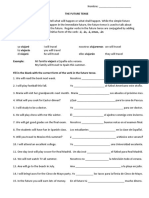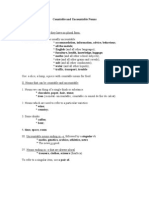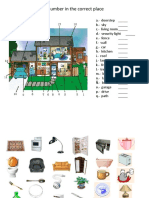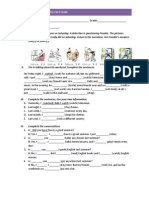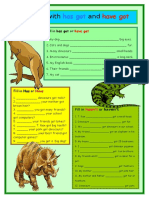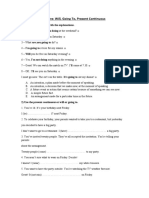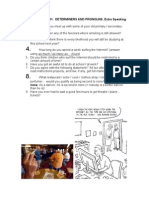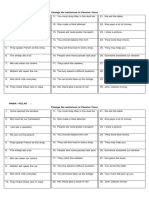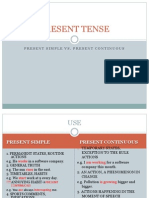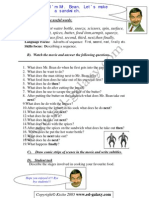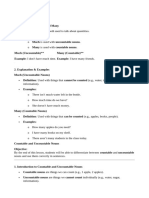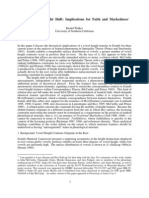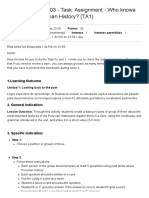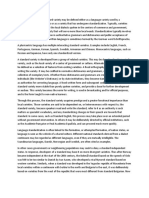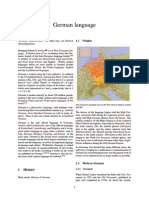A Few A Little A Lot of
A Few A Little A Lot of
Uploaded by
Matilda EftimovaCopyright:
Available Formats
A Few A Little A Lot of
A Few A Little A Lot of
Uploaded by
Matilda EftimovaOriginal Title
Copyright
Available Formats
Share this document
Did you find this document useful?
Is this content inappropriate?
Copyright:
Available Formats
A Few A Little A Lot of
A Few A Little A Lot of
Uploaded by
Matilda EftimovaCopyright:
Available Formats
ESL Beginning Level
Pair Practice Vocabulary Building Fill In
1 Directions: Read and pronounce the names of the items below.
slice glass
water tickets bread
A little, A few & A lot of
carton
milk cash homework pencils friends
cup
coffee coins
spoon
liter/ gallon
people gas books dollars problems
plate
lock
sugar
food
relatives
hours
hair
Directions: List the items above under A FEW or A LITTLE below.
(Count) tickets _______________________________________ _______________________________________ _______________________________________ _______________________________________ _______________________________________
with How much? and How many? Answer using a little, a few, and a lot of. See the examples
A FEW
(Non-count) water _______________________________________ _______________________________________ _______________________________________ _______________________________________ _______________________________________
water do you see? I see a little water? How many tickets do you see? I see a few tickets.
A LITTLE
2 Directions: Practice asking with another student How much
Student 1: How much/How many _______ do you see? Student 2: I see _________ .
3 Directions: Write a few, a little, or a lot of below.
4 Interview: Ask another student the
Student Sur vey
How many How much tea How many apples are do you drink? people are there? There I drink _______ there? I see a few apples. __________tea. ______ people. ______
questions below. Write the answers using a few, a little, or a lot of.
How many children are there? There are ________.
1. How many brothers/sisters do you have? ________ 2. How many relatives do you have? ____________ 3. How much money does gas cost? ____________ 4. How many hours do you sleep? ______________ 5 6 5. How many books do you read in a year?_______ 6. How many close friends do you have?_________ 7. How many hours do you study? ______________ How much fruit How much cash 8. How much do you like __________? __________ do you eat? I is in the photo? 9. How much __________________ ? __________ eat _________ Its__________ _________fruit. _____ money. 10. How many __________________? __________
Paul J. Hamel 2010 Lesson 0099
elsworksheetsandlessonplans.com
ESL Beginning Level
Pair Practice Vocabulary Building Fill In
1 2
Before distributing the worksheet, begin the lesson with a conversation using how much and how many to determine how much the students already know about how these expressions are used. (See lesson How much & How many, Item #0098). Distribute the worksheet. Introduce the vocabulary and pronounce the names of the items for each photo. Have the students model the pronunciation of the words after you. Make sure that the students know the following countable nouns: glass, carton, cup, slice, spoon, liter, gallon, lock (of hair), and plate. Point out that these words are countable and can be used with non-countable words in expressions with of. Examples: a glass of water, a carton of milk, a cup of coffee, a slice of bread, a spoon of sugar, a liter/gallon of gas, a lock of hair, and a plate of food. Explain that we use a few for items that can be counted and a little for items that cannot be counted. Then, direct the students to list the items in the photos under the columns A FEW or A LITTLE. Introduce the structure by asking questions such as the examples below. Continue asking similar questions about the remaining photos. How much water do you see in the photo? How many tickets do you see? How much money do you want? How many friends do you have? How much do you like ice cream? I see a little water. I see a few tickets. How much coffee do you drink? How much food you eat for dinner? How many hours do you study?
Teachers Notes
3 4
Vary the questions by using other verbs such as want, have, need, eat, drink, study, like, etc. Examples:
Explain that a lot of is the opposite of a little and a few and is used with both count and non-count nouns. Examples: How many friends do you have? I have a lot of friends. How much money do you want? I want a lot of money. Repeat the drill in exercise 2 eliciting answers with a lot of. Ask about friends, relatives, cousins, the cost of a car, gas, etc. Direct students to exercise 3 on the worksheet. Identify the items in the photos and have students repeat them after you. As a oral exercise ask the students to use a little, a few, and a lot of in the blank spaces below the photos. Expand the activity by asking for volunteers to pose original questions using How much and How many using a little, a few, or a lot of in the answers. Finally, have the students write the expressions on the blank lines provided. (Answers: 1. a few; 2. answers will vary; 3. a lot of; 4, a lot of; 5. answers will vary; 6. a lot of) Direct the students to the Student Survey in exercise 4 at the bottom of the worksheet. As an active listening and reading exercise, read the questions to the class orally and have the students underline any unknown words. Then, explain any unfamiliar vocabulary. Ask the students to provide two original questions at the end of the survey. Finally, discuss the answers in a class discussion. FOLLOW UP ACTIVITIES
Emphasize the use of such words as food, money, work, furniture, and hair with the question How much? Some students tend to use the question How many? with these words. It may be useful to drill these in the following types of contrasts: How much money? A little money. How much work? A little work. Stress that the use of the article a is essential. Lack of the article produces a negative impression. Compare: I have little time. (almost none) I have a little time. (a small quantity) I have few friends. (almost none) I have a few friends. (some)
Paul J. Hamel 2010 Lesson 0099
10
elsworksheetsandlessonplans.com
You might also like
- The Grammar Plan Book 1 - Parts of SpeechDocument77 pagesThe Grammar Plan Book 1 - Parts of Speechapi-231515740100% (3)
- Money Idioms MatchingDocument1 pageMoney Idioms MatchingMartin Sketchley100% (4)
- Spanish Future Tense WorksheetDocument1 pageSpanish Future Tense Worksheetsarafina juma0% (1)
- Possessive Adjectives PronounsDocument3 pagesPossessive Adjectives PronounsNicolás Aldunate100% (1)
- WORKSHEET Too Enough So SuchDocument6 pagesWORKSHEET Too Enough So Suchostz albanNo ratings yet
- Lesson Plan: Content: Grammar: Verb Will/ Won't For Predictions and DecisionsDocument8 pagesLesson Plan: Content: Grammar: Verb Will/ Won't For Predictions and DecisionsTiti MadisonNo ratings yet
- Passive Infinitive and GerundDocument2 pagesPassive Infinitive and Gerundquynhchi27275% (4)
- Will Vs Be Going To QuizDocument1 pageWill Vs Be Going To QuizScarleth Caroline Bula PaezNo ratings yet
- Countable and Uncountable NounsDocument2 pagesCountable and Uncountable Nounso_claudia1967% (3)
- Fill in The Gaps With The Correct Object PronounDocument2 pagesFill in The Gaps With The Correct Object PronounAndrea Rubio0% (1)
- There Is There Are PowerDocument12 pagesThere Is There Are PowerOscar A.100% (2)
- Simple Past ExamDocument1 pageSimple Past ExamJhoinis Gil Rodelo67% (3)
- Regular and Irregular Plurals - 1Document4 pagesRegular and Irregular Plurals - 1Capital Rooms Hotel100% (1)
- Exercises With The Verb Have GotDocument1 pageExercises With The Verb Have GotAlexandra AlbulescuNo ratings yet
- Present Perfect Simple and Continuous ExercicesDocument8 pagesPresent Perfect Simple and Continuous ExercicesAndreea BudeșNo ratings yet
- Irregular Verbs in The Past Simple TenseDocument4 pagesIrregular Verbs in The Past Simple TenseRobin Millan0% (1)
- 1 Inversion Grammar RulesDocument4 pages1 Inversion Grammar RulesErnesto De La Valle100% (1)
- Just Yet and AlreadyDocument2 pagesJust Yet and AlreadyLUIS ADRIAN NU�EZ CORONELNo ratings yet
- 1: Put The Verb Into The Correct Form, Present Continuous or Present SimpleDocument7 pages1: Put The Verb Into The Correct Form, Present Continuous or Present SimpleVictoria KozlovaNo ratings yet
- Past Tense Simple ExercisesDocument13 pagesPast Tense Simple ExercisesLiviu ChifaneNo ratings yet
- Second Conditional2Document2 pagesSecond Conditional2Sonia Garcia DiazNo ratings yet
- Ejercicios Future (Will, Going To, Present Contiuous)Document11 pagesEjercicios Future (Will, Going To, Present Contiuous)HufflyNo ratings yet
- Will and Going ToDocument6 pagesWill and Going Toعلي عبد الحمزهNo ratings yet
- Present Simple Practise PDFDocument3 pagesPresent Simple Practise PDFJuli B11No ratings yet
- Present Simple Exercises PrimariaDocument12 pagesPresent Simple Exercises PrimariaVane YesteNo ratings yet
- Completa Las Frases Con Should o Shouldn'tDocument1 pageCompleta Las Frases Con Should o Shouldn'tJose MonteroNo ratings yet
- Countable and Uncountable NounsDocument8 pagesCountable and Uncountable NounsAlice WewenNo ratings yet
- Semana 8 Simple Past and ContinuosDocument21 pagesSemana 8 Simple Past and ContinuosrhonnyNo ratings yet
- Teste Daily Routine 6debDocument4 pagesTeste Daily Routine 6debIba LaçiNo ratings yet
- Subject Pronouns and Possessive AdjectivesDocument2 pagesSubject Pronouns and Possessive Adjectiveslpa_20100% (1)
- Quantifiers 49246Document1 pageQuantifiers 49246Julie Pearl Dos SantosNo ratings yet
- Ready For CAE Ss P 101. Determiners and Pronouns. Extra SpeaknigDocument2 pagesReady For CAE Ss P 101. Determiners and Pronouns. Extra SpeaknigtomeualoyNo ratings yet
- Second Conditional ExerciseDocument2 pagesSecond Conditional ExerciseNoreffarizan Ahmad AzamNo ratings yet
- Change The Sentences To Passive VioceDocument2 pagesChange The Sentences To Passive VioceDecy Rahmawati ArisantiNo ratings yet
- Future TensesDocument2 pagesFuture TensesIvana Zečević ToljNo ratings yet
- Subject and Object Pronouns Possessive Adjectives - 93842Document1 pageSubject and Object Pronouns Possessive Adjectives - 93842andres bernalNo ratings yet
- Comparative and Superlative MoversDocument3 pagesComparative and Superlative MoversShayla Palao Bosch100% (1)
- How To Teach The Simple Future TenseDocument3 pagesHow To Teach The Simple Future Tensemadalina2008No ratings yet
- Both Either Neither Grammar Drills Sentence Transformation Rephrasing - 77762Document5 pagesBoth Either Neither Grammar Drills Sentence Transformation Rephrasing - 77762TAARANo ratings yet
- Past Simple vs. Past ContinuousDocument2 pagesPast Simple vs. Past ContinuousRosario Carrión100% (2)
- Adjectives - That - End - in - Ing - or - Ed 3Document1 pageAdjectives - That - End - in - Ing - or - Ed 3elizabetaNo ratings yet
- Present TenseDocument8 pagesPresent TensetudormirceanNo ratings yet
- There Was There Were ExercisesDocument2 pagesThere Was There Were ExercisesDaniela TNo ratings yet
- Question TagDocument6 pagesQuestion TagDena EkaNo ratings yet
- Test Intermediate 2. FinalDocument3 pagesTest Intermediate 2. FinalLUIS MANUEL GONZALES DELGADONo ratings yet
- Simple Present ActivitiesDocument3 pagesSimple Present ActivitiesAnonymous RfaXAqNo ratings yet
- FCE Use of English PracticeDocument2 pagesFCE Use of English PracticelucianabianchiniNo ratings yet
- MR Bean Adverbs of SequenceDocument1 pageMR Bean Adverbs of SequenceSilvana CristaldoNo ratings yet
- Adverbs and AdjectivesDocument3 pagesAdverbs and Adjectivesquynhchi50% (2)
- English WorksheetDocument6 pagesEnglish WorksheetrizkisetiastriNo ratings yet
- Verb To BeDocument25 pagesVerb To Bemartha liliana gómez rojas100% (1)
- Kids Print Weather Words PDFDocument1 pageKids Print Weather Words PDFaszmagNo ratings yet
- Future Simple With Will Be Going To Present Continuous 100203Document2 pagesFuture Simple With Will Be Going To Present Continuous 100203Ei TunNo ratings yet
- 2-in-1 Book Series: Teacher King’s English Beginner Course Book 1 & English Speaking Course Book 1 - Japanese EditionFrom Everand2-in-1 Book Series: Teacher King’s English Beginner Course Book 1 & English Speaking Course Book 1 - Japanese EditionNo ratings yet
- A Few - A Little - A Lot ofDocument2 pagesA Few - A Little - A Lot ofmontielnadia86No ratings yet
- A Few A Little A Lot of PDFDocument2 pagesA Few A Little A Lot of PDFadriana belenNo ratings yet
- Great Writing Activities TESOL Arabia 2008 08Document7 pagesGreat Writing Activities TESOL Arabia 2008 08Sujatha MenonNo ratings yet
- 07 English Grammar - Quantifiers - 01 Countable Vs Uncountable - PDF PDFDocument6 pages07 English Grammar - Quantifiers - 01 Countable Vs Uncountable - PDF PDFFebriant Dita100% (1)
- Much vs. ManyDocument4 pagesMuch vs. ManykatarinaNo ratings yet
- Consolidation 2 of 9th GradeDocument6 pagesConsolidation 2 of 9th Gradejahirsaavedra90No ratings yet
- 1ADocument6 pages1AMarian Serrano LatorreNo ratings yet
- Past Simple or Present SimpleDocument2 pagesPast Simple or Present SimpleMatilda EftimovaNo ratings yet
- Past Simple: Irregular VerbsDocument4 pagesPast Simple: Irregular VerbsMatilda EftimovaNo ratings yet
- ConditionalsDocument1 pageConditionalsMatilda EftimovaNo ratings yet
- Complete The Conditional SentencesDocument3 pagesComplete The Conditional SentencesMatilda EftimovaNo ratings yet
- English Sentences Can Be in Either Active or Passive VoiceDocument2 pagesEnglish Sentences Can Be in Either Active or Passive VoiceMatilda EftimovaNo ratings yet
- Crayon Colors PDFDocument1 pageCrayon Colors PDFMatilda EftimovaNo ratings yet
- Possesive Pronouns PDFDocument6 pagesPossesive Pronouns PDFMatilda EftimovaNo ratings yet
- WH Question TestDocument4 pagesWH Question TestMatilda EftimovaNo ratings yet
- Look at The Pictures - Make Sentences Giving Advice To These People - Use ShouldDocument1 pageLook at The Pictures - Make Sentences Giving Advice To These People - Use ShouldMatilda EftimovaNo ratings yet
- Gs Comparative and SuperlativeDocument2 pagesGs Comparative and SuperlativeMatilda EftimovaNo ratings yet
- Gs Comparative and SuperlativeDocument2 pagesGs Comparative and SuperlativeMatilda EftimovaNo ratings yet
- Simple Past Vs Present PerfectDocument3 pagesSimple Past Vs Present PerfectMatilda EftimovaNo ratings yet
- Complete List A-Z of Irregular Verbs: Base Form Past Simple Form Past Participle FormDocument7 pagesComplete List A-Z of Irregular Verbs: Base Form Past Simple Form Past Participle FormMatilda EftimovaNo ratings yet
- Nota GrammarDocument7 pagesNota GrammarAlmizan Hanim Ab KadirNo ratings yet
- Proofreading WorksheetDocument1 pageProofreading WorksheetMark KopytinNo ratings yet
- Tugas 1 Structure IDocument2 pagesTugas 1 Structure Idesound Phinisi PointNo ratings yet
- Pri Eng 2ed Tr4 Midpoint Test AnsDocument3 pagesPri Eng 2ed Tr4 Midpoint Test AnsWarda MehmoodNo ratings yet
- English Practical Course: 1st Year, LMA, 1st Semester - As. Dr. Monica ManolachiDocument2 pagesEnglish Practical Course: 1st Year, LMA, 1st Semester - As. Dr. Monica ManolachiLuizaMarinNo ratings yet
- Greetings and Common ExpressionsDocument6 pagesGreetings and Common ExpressionsMary Jane AguinaldoNo ratings yet
- Bukusu Riddles - IDocument67 pagesBukusu Riddles - IMartin Walsh100% (1)
- The Verb: Category of NumberDocument5 pagesThe Verb: Category of NumberSasha KravchenkoNo ratings yet
- Semi Detailed in Grade 7Document2 pagesSemi Detailed in Grade 7Anne TonNo ratings yet
- How To Make The Present Continuous TenseDocument4 pagesHow To Make The Present Continuous TensePedro BeltreNo ratings yet
- Gender: Maarten MousDocument16 pagesGender: Maarten MousleetolbeanNo ratings yet
- Rule5 PDFDocument8 pagesRule5 PDFcmaheswara-1No ratings yet
- Military English 4Document1 pageMilitary English 4María José Martínez FernándezNo ratings yet
- Lesson Plan Subject VerbDocument3 pagesLesson Plan Subject VerbChanelle Honey VicedoNo ratings yet
- Esimbi Vowel Height Shift: Implications For Faith and MarkednessDocument14 pagesEsimbi Vowel Height Shift: Implications For Faith and MarkednessFede FretesNo ratings yet
- EPJA - English Test - Present SimpleDocument3 pagesEPJA - English Test - Present SimpleTamara MirandaNo ratings yet
- On The Uses of OneDocument6 pagesOn The Uses of OneTruong Phong TuyenNo ratings yet
- The Pioneer-Hindi-Edition-17 Jun 2021Document12 pagesThe Pioneer-Hindi-Edition-17 Jun 2021Hema and syedNo ratings yet
- March 6-10Document2 pagesMarch 6-10api-328703209No ratings yet
- (ACV-S03) Week 03 - Task - Assignment - Who Knows More About Peruvian History - (TA1)Document6 pages(ACV-S03) Week 03 - Task - Assignment - Who Knows More About Peruvian History - (TA1)Asociacion Nuevo San IsidroNo ratings yet
- Standardization Process AssignmentDocument6 pagesStandardization Process AssignmentAlphahin 17No ratings yet
- German LanguageDocument25 pagesGerman LanguageGirish NarayananNo ratings yet
- New Headway Plus Intermediate: Presented by Assit - Lect. Rafal NaserDocument18 pagesNew Headway Plus Intermediate: Presented by Assit - Lect. Rafal Naserهيا عبد الحكيم ماهرNo ratings yet
- English Admin NotesDocument6 pagesEnglish Admin NotesAshique Ali RajparNo ratings yet
- FRENCH (FREN144) - Coursestruct PDFDocument4 pagesFRENCH (FREN144) - Coursestruct PDFSwathi GudivadaNo ratings yet
- Go Getter 2 Students Book PDF Adverb Adjective 2Document1 pageGo Getter 2 Students Book PDF Adverb Adjective 2Марина КручикNo ratings yet
- Chapter 1.5 by WellsDocument1 pageChapter 1.5 by WellsPizza te amoNo ratings yet
- Will 3Document1 pageWill 3Sol RuizNo ratings yet


